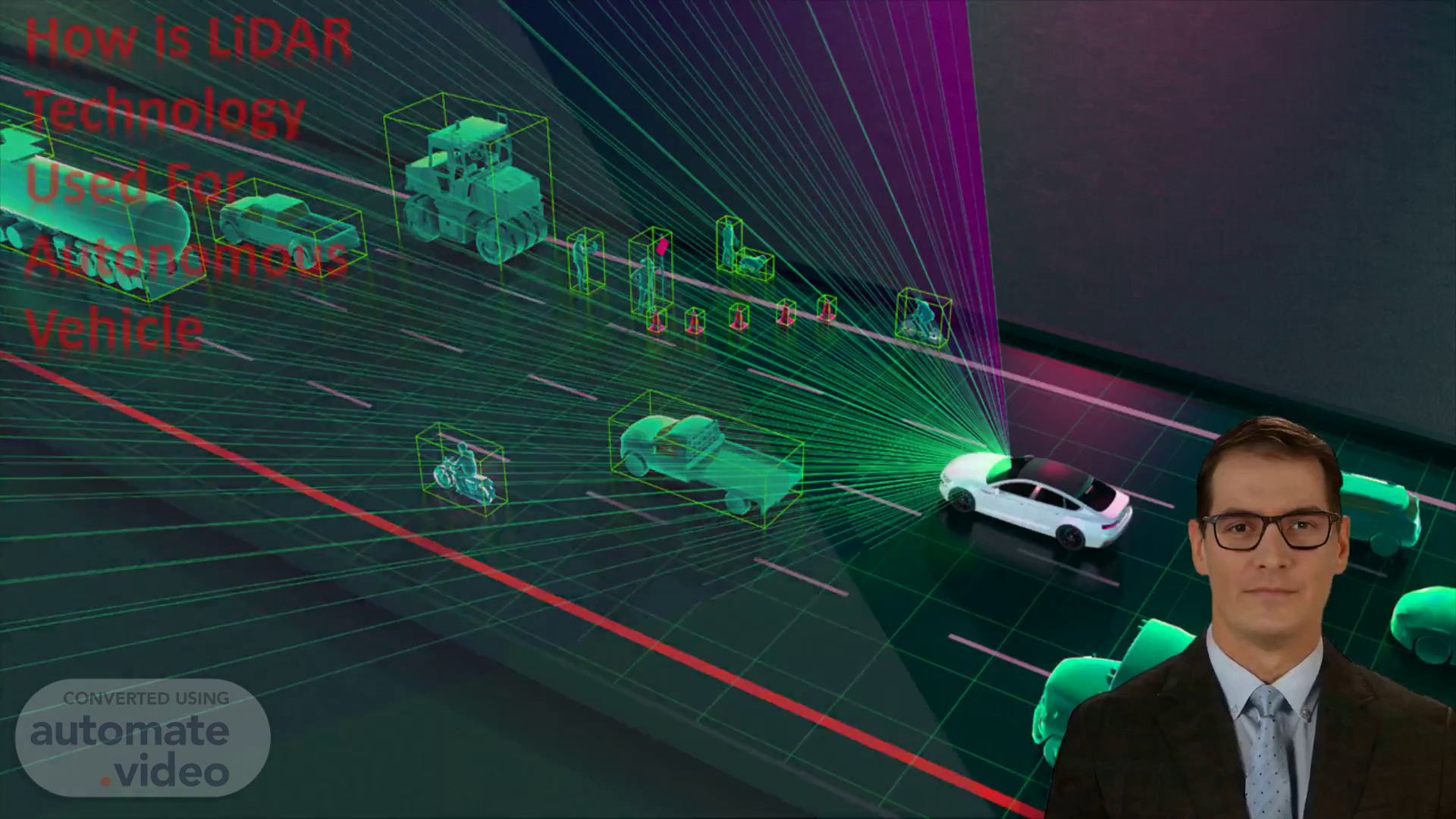
Page 1 (0s)
[Virtual Presenter] Good morning everyone. Today I will be talking about LiDAR technology and how it can be used to enable safe and precise navigation in autonomous vehicles. I will be discussing the various advantages and challenges associated with this technology, as well as its potential use in the future. I am open to your questions and input..
Page 2 (22s)
[Audio] LiDAR, short for "Light Detection and Ranging," is a cutting-edge technology that is transforming the world of autonomous vehicles. It utilizes lasers to measure the distances between objects, which permits autonomous vehicles to gain a better understanding of their surroundings and make smarter decisions. In this presentation, we will delve into what LiDAR is, its components, how it operates, the benefits and difficulties it poses for autonomous vehicles, and the outlook of LiDAR in the automotive industry..
Page 3 (53s)
[Audio] LiDAR, an acronym for Light Detection and Ranging, is a groundbreaking technology that utilizes lasers to measure distances and map the physical lay of the land for self-driving vehicles. It does this by emitting laser pulses that quickly rebound off of objects within the environment and are then reflected back to the car's sensors, allowing it to accurately gauge the shape, size, range and additional features in the space, thereby enabling it to better identify potential hazards and maneuver accordingly..
Page 4 (1m 22s)
[Audio] LiDAR is a cutting-edge technology with tremendous potential to revolutionize the automotive industry. It uses laser light to measure distances and build detailed 3D maps of the environment, improving the ability of autonomous vehicles to identify obstructions and navigate precisely, regardless of weather or lighting condition..
Page 5 (1m 43s)
[Audio] Laser Light Detection and Ranging (LiDAR) technology utilizes laser to send out a light pulse which is then reflected off the environment. By measuring the time taken for the pulse to return back, the distance from the object is measured using the speed of light formula. This data is then used to create a point cloud of numerous points to create a detailed map of the environment..
Page 6 (2m 7s)
[Audio] LiDAR is a vital technology for autonomous vehicles as it uses a laser to scan the environment and generate a 3D image or model of the area. This model is then utilized by the autonomous vehicle to decide how to move and find a path. The components that make up a LiDAR sensor consist of a laser source, a scanner/mirror, a photodetector, timing and control electronics, an optical system, data processing unit, GPS & IMU, and a housing and mounting. By incorporating all of these parts into one unit, LiDAR can create a 3D map of the environment at a great speed and with precision, making it indispensable for autonomous vehicle navigation..
Page 7 (2m 50s)
[Audio] LiDAR technology provides numerous benefits for autonomous vehicles. Its extreme accuracy and range enable the vehicle to accurately identify and navigate around obstacles, no matter the terrain. Additionally, LiDAR works in all lighting conditions, from pitch black to full sun, providing a comprehensive view of the environment. Its wide field of view helps the vehicle detect objects from a wide angle, lending to its precision and ensuring successful navigation of autonomous vehicles..
Page 8 (3m 22s)
[Audio] LiDAR, a remote sensing technology, utilizes a laser to measure distances and generate 3D maps. Its use in the development of autonomous vehicles is essential, granting them a comprehensive understanding of their environment, but also brings forth some challenges. These comprise cost and size, environmental influences, reduced range, interference and false positives, vibration and shock, data processing, integration, perception in complex environments, power consumption and legal matters. All these must be considered when introducing LiDAR technology into self-driving vehicles..
Page 9 (4m 2s)
[Audio] LiDAR technology has become increasingly popular in the autonomous vehicle sector due to its ability to deliver an accurate 3D image of its surroundings. With improved data processing, LiDAR can detect objects to improve safety, avoid collisions, and improve navigation. Solid-state LiDAR has improved its range and resolution, plus cost reduction, which allows the technology to become even more widely used in the industry. When combined with artificial intelligence, LiDAR can work with other important sensors to give autonomous vehicles the most precise and reliable data, thus indicating a bright future for both LiDAR and autonomous vehicle technology..
Page 10 (4m 43s)
[Audio] LiDAR technology is a revolutionary tool that has enabled autonomous vehicles to navigate their environment in a safe manner. It utilises pulses of light that reflect off obstacles and creates a 3D map of the environment. This 3D map can then be used to detect and avoid obstacles, thus ensuring that the cars drive safely and effectively. Through the use of LiDAR technology, the automotive industry is looking to revolutionize the way we drive and our overall experience on the roads..
Page 11 (5m 16s)
[Audio] Today, we will delve into the topic of how LiDAR technology is used for autonomous vehicles. LiDAR, which is short for Light Detection and Ranging, is an essential sensor for autonomous vehicles. This technology utilizes lasers to create a real-time map of the surrounding environment. It works by emitting laser light that reflects off objects and back to the sensor. This data can then be used to create a 3D point cloud, which can be used to detect obstacles, as well as the exact location of the autonomous vehicle. LiDAR can also detect how far away other vehicles are, allowing for more efficient driving decisions. With this technology, autonomous vehicles can better understand their environment and make better decisions when driving..
Page 12 (6m 6s)
THANK YOU.